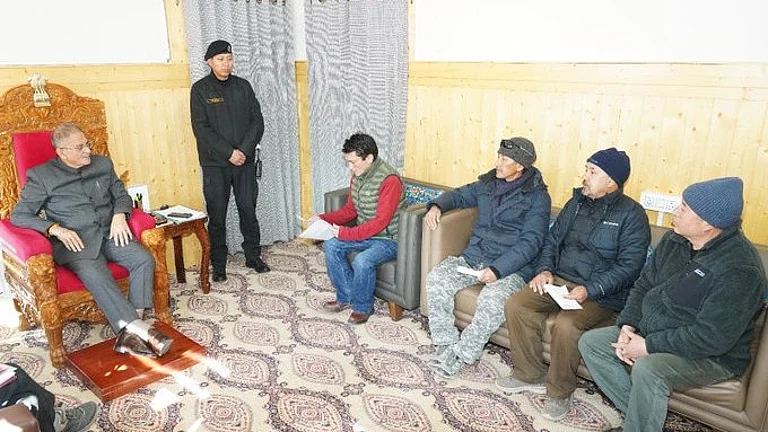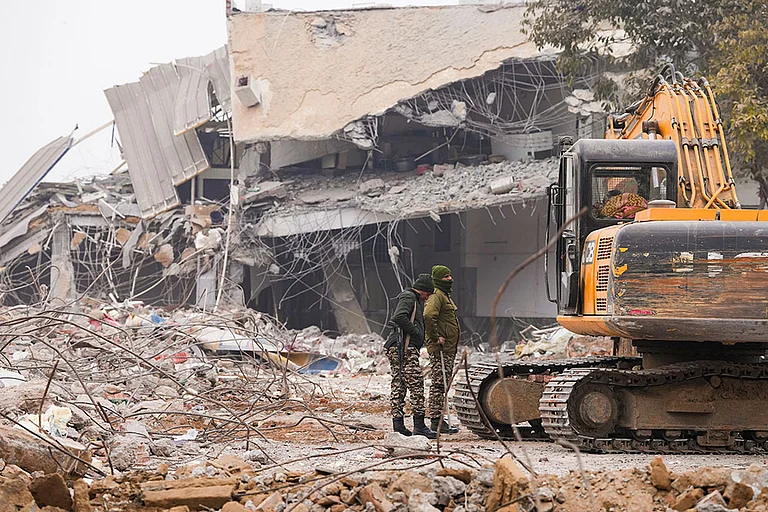A few people had gathered outside a nondescript house in a neighbourhood in Imphal, Manipur’s capital city, on the evening of June 9. Some of them quickly signalled to this reporter, who was seated inside a car, to come out. “Come in quick,” one of them said, urgently pointing at the door of the house.
The group—of about 10 people—were among the few Kuki-Zos who had stayed back in Imphal after ethnic clashes broke out with the Meiteis on May 3. The violence started in the bordering areas of Churachandpur, a Kuki-dominated district, and Bishnupur, a Meitei-dominated district, after several tribal groups staged a protest against the demand of the Meitei community for Scheduled Tribe status.
As news of the violence spread—which occurred in the Torbung area, located between Churachandpur and Bishnupur—Meitei mobs attacked Kuki houses in Imphal, located in the Meitei-dominated valley. In the days that followed, tens of thousands of Kukis were forced to flee to the Kuki-dominated hill areas. But a few remained.
“They (Meitei mobs) came in groups with weapons. They burnt down vehicles. Our Meitei neighbours tried to stop them, but they forced their way through,” says John (name changed). He adds, “How many years does it take to not be considered a refugee? This is our birthplace. We want to die in our house.” Kim (name changed), who was wearing a surgical mask, adds, “We are probably the last remaining Kukis in Imphal. If we leave, that means the state is truly divided.”
Meanwhile, thousands of Meiteis living in Kuki-dominated areas also met a similar fate as their houses were burned. Among those who were forced to flee their homes in the Churachandpur district to the valley was 33-year-old Konthoujam Hemachandra. Sitting inside a relief camp, set up at a training centre of the Sports Authority of India at Utlou in Bishnupur district, Hemachandra says, “I was born and brought up (in Churachandpur), and my family has been staying there since my grandfather moved in the 1960s. Right now, all those who were evacuated from Churachandpur want to go back.”
Internally Displaced
According to the 2011 Census, the Meitei community makes up for over half of Manipur’s population—27.21 lakh—and is primarily based in and around Imphal. The tribal Kuki-Zo and Naga communities constitute 40 per cent of the state’s population and live in the surrounding hills.
An earlier report published in Outlook quoted a state police official as saying that the violence was allegedly provoked after a few unidentified people attempted to burn the Anglo-Kuki Centenary Gate, which was built to commemorate the 1917-1919 Kuki uprising against the British.
“At Churachandpur, there was a Meitei house that was vandalised, but news started spreading that Kuki mobs were vandalising Meitei villages,” the officer was quoted as saying in the report dated July 31. Soon after, Meitei mobs began attacking neighbourhoods in Imphal, which have sizeable Kuki populations.
“We had called for a water tanker. The driver of the tanker called us and said that they (the mob) had halted his vehicle. When we went out, we heard the sound of tear gas. We also got to know that they (the mob) were planning to attack Kuki houses,” says Khullakpam Shaheen, a Meitei Pangal (Meitei Muslim) who lives in the New Lambulane area of Imphal. “The New Lambulane area is like mini Manipur; people of all communities live here,” says Shaheen. The mob attacked and burnt the only Kuki house on the street in New Lambulane where Shaheen and her family live.
Two streets away, a 70-year-old resident, a Kuki, who didn’t wish to be named, was inside his house when he heard about the mob. He says, “One of the boys who works for me said that the situation isn’t good. So we started preparing to go to the 1st Manipur Rifles Camp. Before I left, I could only hear the mob saying that they wanted to kill us. I had been living there since 1984 and had recently renovated the house. As I am retired, I was going to live out my life in that house.”
Over a month after the violence started, New Lambulane had transformed completely—barricades were put in place to block access to neighbourhoods; signs were put up outside houses declaring which community the families belonged to; and, army personnel patrolled the neighbourhoods. In a way, it’s a microcosm of the current Manipur—physical boundaries between communities and looming paranoia and fear etched on the faces of the residents.
Fear and Panic in Churachandpur
Three kilometres from the main Churachandpur town in a Meitei neighbourhood, Hemachandra’s family was constantly following updates of the unfolding situation on May 3. “Through a viral video, we saw the violence in Torbung; people were pelting stones. We didn’t think the violence would spread. But the Kukis started destroying some houses on the nearby road,” says Hemachandra. “Between 7:30 PM and 8 PM, many Kuki volunteers approached my area with JCB machines, bulldozers, bikes and weapons. They screamed that this was their land and that we should leave. All the Meiteis in this locality (500 of them) started running,” he says.
Hemachandra and his family sought shelter in the house of a Mizo residing in Churachandpur. “We stayed there for a night. The next night, a few people advised us to go to the Assam Rifles camp. At 3:30 PM on May 4, we snuck out and went to the camp. We stayed there for seven days before being evacuated by the CRPF (Central Reserve Police Force),” he says.
For both Kuki-Zo and Meitei families who have been displaced, the journey towards reconciliation seems to be a long one. “To return to harmony, the most important thing is to identify and deport the illegal migrants and the SoO (Suspension of Operations) agreement should be withdrawn immediately. So far, the entire district has been administered by gun power. If we set up a business, we will have to pay tax to the militants,” says Hemachandra.
Most of the valley-based civil society organisations, including the Coordinating Committee on Manipur (COCOMI), have claimed that the influx of Kuki-Chin people from Myanmar is at the centre of the ongoing conflict. They have also claimed that armed groups under the SoO pact—which the groups had signed with the Union and state governments—had violated provisions of the agreement by allegedly leaving the designated camps.
Meanwhile, the Kuki-Zo families have reiterated their demands for a separate state and administration. “Even in our wildest dreams, we never thought that this would happen. Earlier, there have been some communal skirmishes, but the government was always able to control that. Now there is no rule of law,” says the 70-year-old Kuki man quoted above.
On August 16, 10 Kuki-Zo MLAs, including eight from the BJP, submitted a memorandum to Prime Minister Narendra Modi asking that “posts equivalent to Chief Secretary and DGP” must be set up for the five hill districts of the state, namely Churachandpur, Kangpokpi, Chandel, Tengnoupal and Pherzawl.
(Views expressed are personal)
Angana Chakrabarti in Imphal
(This appeared in the print as 'No Truce In Sight')























